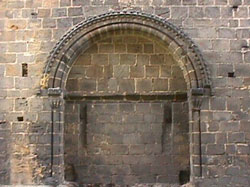 |
 |
 |
 |
 |
 |
 |
|
The presbytery
The presbytery, with the High Altar, was the centre of liturgical ritual. The reserved sacrament was kept here, and it was the setting for the daily immolation of Christ at the conventual Mass. The presbytery was, accordingly, imbued with a special sanctity and separated from the monks’ choir by two steps. The officiating clergy, namely, a priest, a deacon and a sub-deacon, presided here during Mass, and a wooden or stone seat (sedilia) was carved into the wall for their use. The rest of the community observed proceedings from the choir; as participants they were to a certain extent visually involved, but physically removed. Untonsured monks were only permitted to ascend the sanctuary step to receive Communion.(5) A veil concealed the sanctuary during Lent, and the two rings from which this was hung can be seen in the abbey church of Dore, Herefordshire.(6) On the first Saturday of Lent the curtain was drawn after Compline and removed after Compline on the Wednesday before Easter. On Saturdays and feasts of two lessons, however, it was opened at Vigils and remained so until the following day at Vespers. (7) The High Altar was raised, unadorned and strikingly bare. Gold and silver were expressly prohibited and a simple wooden cross was placed upon the altar, along with the host in a pyx. Pictures of Christ were permitted, as long as they were of one colour, and from the late twelfth century a reliquary might be placed on the altar during Mass on feast days.(8) |
